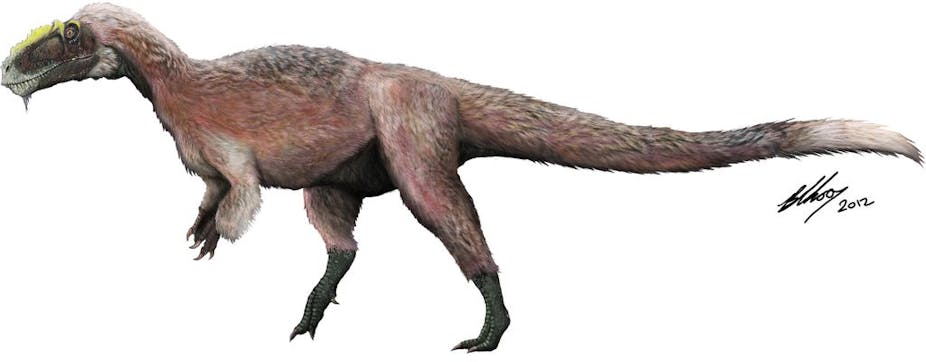It’s taken a century of debate, but in the past two decades we’re finally understanding where birds came from. Now, with a new study published in the journal Nature, Chinese and Canadian researchers have further developed our understanding of avian evolution with the discovery of Yutyrannus huali, a new species of feathered Tyrannosaur.
This finding builds on a long history of work trying to understand how birds and dinosaurs are related, helped by a spate of recent discoveries of “missing links” – bipedal, carnivorous dinosaurs (or theropods), exhibiting quintessentially avian features, such as wishbones and feathers.
These transitional forms have cemented the view that birds are nothing more than a strange but very successful lineage of dinosaurs that developed feathers, wings and powered flight. Birds are dinosaurs, just as humans are a bizarre group of hairless bipedal primates.

One of the clinchers was the discovery of theropods with feathers, preserved exquisitely in fine volcanic ash in China.
Because feathers are such an intricate evolutionary innovation – like the five-digit vertebrate limb – they are unlikely to have evolved more than once. As a result, the bipedal carnivorous theropods must be closely related to birds, with both groups acquiring their plumage from a common feathered ancestor.
This realisation helped fuel the Hollywood interpretation of Velociraptor – such as in the Steven Spielberg classic Jurassic Park – as an agile avian creature rather than a sluggish reptile.
Feathers are an evolutionary wonder, being useful for flight, insulation, mating displays, and UV protection. They are so indispensable they have never been lost in any of the thousands species of living birds, and the same should be true in their dinosaurian ancestors.

The presence of feathers in some of the oldest and most primitive theropods – such as Sinosauropteryx – indicates feathers appeared very early in theropod evolution. As a result, feathers should have characterised all advanced theropods, including gigantic forms such as Tyrannosaurus rex.
And yet they were only ever found in small theropods, no bigger than a typical human.
This was puzzling, and one attractive explanation was that larger dinosaurs, with their huge reservoir of body heat and low surface-area-to-volume ratio, had little need for insulation and therefore dispensed with feathers.
In a similar way, living elephants are so large they don’t need hair to keep warm, and are among the least hirsute of mammals.
The dilemma posed by the lack of large dinosaurs with feathers has been resolved by the discovery of Yutyrannus huali by an international team led by Professor Xing Xu, a researcher from the Institute of Vertebrate Paleontology and Paleoanthropology at the Chinese Academy of Sciences.

Yutyrannus was a huge predator that weighed over a tonne and was a primitive relative of T. rex. It had evolved some advanced tyrannosaur features, such as a huge skull with a deep snout, but still retained other primitive features such as a large forelimb with three-fingers (as opposed to T. rex’s famously puny two-fingered arm).

All three known individuals of Yutyrannus also possessed an impressive plumage of long fine feathers, some over 20cm long. Unfortunately, we don’t yet know the colour of these impressive feathers, as the pigment cells were not reported.
(Amazingly we do know the colours of some other dinosaurs and extinct birds. Pigment cells in feathers can be fossilised under optimal conditions, such as rapid burial under fine volcanic ash, and pigment cells of different colours have distinctive shapes and texture. A recent study of an Archaeopteryx feather demonstrated it was black.)
Feathers are clearly present on all three specimens of Yutyrannus found by Xing Xu and colleagues, but there is no evidence of feathers in T.rex, which seems to have left scaley skin impressions.

As a result, Yutyrannus was probably fluffier than its famous cousin, though T. rex may have sported some plumage in restricted areas, just as humans retain typical mammal hair but only in strategic patches.
The reasons for this difference are speculative, but one attractive possibility implicates climate. While T. rex lived in at the end of the Cretaceous, in a warm greenhouse world, Yutyrannus lived in an earlier, much more frigid world where even a large dinosaur might have required insulation. We only need to think of the elephant and the woolly mammoth for a more recent analogue.
The new discovery elegantly demonstrates what many palaeontologists had predicted: many, if not most, of the predators during the Age of the Dinosaurs were cloaked in feathers.

